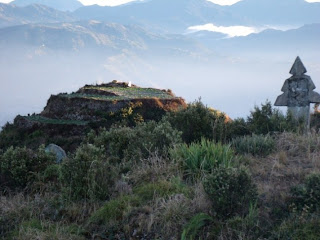 me to a "climb-for-beginners". Being another first for me, I decided to sign up. Roughly 4 hours from Baguio, we finally arrived at Timbak Elementary school. Good thing we were welcomed to stay in the school as long as we keep the place clean and quiet, therefore we didn't have to bring tents. The view of the sunset was already a treat even without climbing the summit.
me to a "climb-for-beginners". Being another first for me, I decided to sign up. Roughly 4 hours from Baguio, we finally arrived at Timbak Elementary school. Good thing we were welcomed to stay in the school as long as we keep the place clean and quiet, therefore we didn't have to bring tents. The view of the sunset was already a treat even without climbing the summit.  The following morning, we woke up early, around 3:30 am, had an early breakfast and prepared for assaulting the peak of Mt. Timbak. We were a large group of almost 20+ heads and Ronald decided to divide the group into 2, each team taking 2 different trails on the way up - the summit. The other group was led by Mr. Jay Z Jorge. The hike was considered to be for beginners but one still has to fight the cold and the thin air, but everything got easier as we went up and got our bodies warmer. we found ourselves walking alongside vegetable crops, careful not to damage any of the plants that is a source of livelihood for most people living in the area.
The following morning, we woke up early, around 3:30 am, had an early breakfast and prepared for assaulting the peak of Mt. Timbak. We were a large group of almost 20+ heads and Ronald decided to divide the group into 2, each team taking 2 different trails on the way up - the summit. The other group was led by Mr. Jay Z Jorge. The hike was considered to be for beginners but one still has to fight the cold and the thin air, but everything got easier as we went up and got our bodies warmer. we found ourselves walking alongside vegetable crops, careful not to damage any of the plants that is a source of livelihood for most people living in the area.Af


People in Timbak (Atok and Kabayan municipalities) are genuinely kind. They don't expect monetary gifts for their kindness (and one shouldn't even attempt to offer them money) and meeting them is such a breath of fresh air. The simplicity of their way of life reminds me that happiness and peace can truly be achieved even without the cultural and technological "advancement" people in the cities are very much proud of. 

*** On a side note, I'm currently in the stage of building my 2nd Aquaponic system, almost 5 times larger than the first. I am going to use the CHOP (Constant Height One Pump) system since I wanted to make use of the unused 550-gallon plastic drum as a fish tank and an old, broken refrigerator as a growbed. I am hoping to be able to finish the project by tomorrow before I got back to work. Peace.












